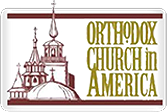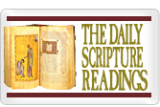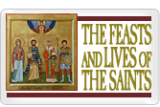Questions about the Sunday of the Cross
Adapted from excerpts from two articles by:
The Antiochan Orthodox Archdiocese of North America, and St. Nicholas Orthodox Church, McKinney, Texas.
How was the cross foreshadowed in the Old Testament?
1. In the book of the prophet Ezekiel (9:6) it is said that when the Angel of the Lord was sent to punish and destroy the sinning people, it was told him not to strike those on whom the "mark" had been made. In the original text this mark is called "tau," the Hebrew letter corresponding to the letter "T" which is how in ancient times the cross was made, which then was an instrument of punishment.
2. Exodus, 14 and 17: Moses, who held his arms raised in the form of a cross during the battle, gave victory to the Israelites over the Amalekites. He also, dividing the Red Sea by a blow of his rod and by a transverse blow uniting the waters again, saved Israel from Pharaoh, who drowned in the water, while Israel crossed over on the dry sea bed.
3. Elisha brought a child back to life again by stretching upon him in the form of a cross (2 Kings 4:32-35): “And when Elisha was come into the house, behold, the child was dead, and laid upon his bed. He went in therefore, and shut the door upon them twain, and prayed unto the Lord, and he went up, and lay upon the child, and put his mouth upon his mouth, and his eyes upon his eyes, and his hands upon his hands: and he stretched himself upon the child; and the flesh of the child waxed warm. Then he returned, and walked in the house to and fro; and went up, and stretched himself upon him: and the child sneezed seven times, and the child opened his eyes.”
How did Jesus prophesy His death on the Cross?
John 12:23-33: “And Jesus answered them, saying, The hour is come, that the Son of man should be glorified. Verily, verily, I say unto you, except a corn of wheat fall into the ground and die, it abideth alone: but if it die, it bringeth forth much fruit. He that loveth his life shall lose it; and he that hateth his life in this world shall keep it unto life eternal. If any man serve me, let him follow me; and where I am, there shall also my servant be: if any man serve me, him will my Father honor. Now is my soul troubled; and what shall I say? Father, save me from this hour: but for this cause came I unto this hour. Father, glorify thy name. Then came there a voice from heaven, saying, I have both glorified it, and will glorify it again. The people therefore, that stood by, and heard it, said that it thundered: others said, An angel spake to him. Jesus answered and said, This voice came not because of me, but for your sakes. Now is the judgment of this world: now shall the prince of this world be cast out. And I, if I be lifted up from the earth, will draw all men unto me. This he said, signifying what death he should die.”
Whom did Jesus tell would die on a cross?
Jesus said to Peter (John 21:18-19):
“Verily, verily, I say unto thee, When thou wast young, thou girdedst thyself, and walkedst whither thou wouldest: but when thou shalt be old, thou shalt stretch forth thy hands, and another shall gird thee, and carry thee whither thou wouldest not. This spake He, signifying by what death he should glorify God. And when He had spoken this, He saith unto him, Follow me.”
Normally Christians do not prostrate themselves on Sunday. Why?
On the Sunday of the Holy Cross we do prostrate. Why and when?
Christians do not prostrate on Sunday because this is the day we always celebrate the Resurrection, and we recall how God is able to make us stand. Our standing reminds us of the resurrection.
There are Sundays when we do prostrate (the Third Sunday of Great Lent, and the Exaltation of the Holy Cross, if it falls on a Sunday.)
On this day, the hymn "Before Thy Cross," which we sing while making a prostration, teaches us what our prostrations mean:
“Before Thy Cross, / we fall down in worship, O Master, / and Thy holy Resurrection / we glorify.”
When we prostrate, it is in worship of the Risen Lord, and when we raise ourselves up, we glorify His Resurrection.
An Orthodox prostration begins with making the sign of the Cross, then bending onto hands and knees, and bowing the head to the floor, then getting back up.
Where, when, how and by whom was the true Cross discovered?
St. Helena (Helen), the mother of St. Constantine, discovered the Holy and Precious Cross during excavations in Jerusalem, in the 4th century. In the twentieth year of his reign, the Emperor Constantine sent his mother Saint Helen to Jerusalem to venerate the holy places and to find the site of the Holy Sepulchre and the Cross.
Searching for the Cross, she questioned local persons, but her search remained unsuccessful. However, in 326, she was directed to an elderly Hebrew man named Jude who stated that the Cross was buried at a pagan temple. (He became a Christian afterwards.) St. Helen ordered that the pagan temple be demolished, and the ground was excavated. Soon, the Sepulchre of the Lord was uncovered. Not far from it were three crosses.
In order to determine the cross on which the Savior had been crucified, Patriarch Macarius, who was present, alternately touched the crosses to a corpse. When the dead man was touched by the True Cross, he came to life. Having beheld the raising of the dead, everyone was convinced that the Cross of Christ was found. During the discovery of the Cross, another miracle took place – a sick woman was healed instantly when the shadow of the Holy Cross fell across her. Saint Helen and her court venerated the Precious and Life-Giving Cross, and many others gathered around to see it. The Patriarch lifted the Cross with both hands so that all of the people gathered could see it. The crowd responded with "Lord have mercy."
What major commemorations of the Cross occur throughout the year?
3rd Sunday of Great Lent (Sunday of the Cross);
Exaltation of the Precious and Life-giving Cross (Sep 14);
Procession of the Holy Cross (Aug 1).




